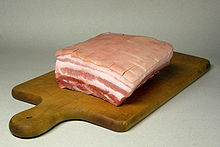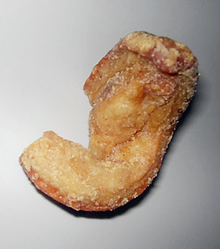Rind (food)
As rind , in Austria also Schwartl , (origin unknown, in the Middle High German as swart [e] the thick human (hairy) is seized) originally scalp or tough thick skin of some mammals referred to in the hunter language the skin of the badger and wild boar , pig skin has been used as food since around the 18th century . Bacon rind is pork bacon with sticky skin.
Pork rind is mainly used as a sausage ingredient when it is cut up and forms the most important raw material for the production of gelatine .
The otherwise tough rind can be consumed directly after prolonged cooking, braising , roasting or baking , which denatures the collagen in the connective tissue and is partially converted into gelatine. Rind is therefore only left on pieces of meat that should be prepared accordingly, such as pork knuckle , belly meat or roast from the ham and shoulder . Boiled or stewed rind has a soft consistency, roasted or baked (pork crust roast) it contracts strongly, which is why it is usually cut several times beforehand, and becomes crumbly and crispy, reheated hard and tough. Rind of smoked pork belly is traditionally cooked in stews and sauces , but not consumed. Especially in Denmark , but also in Central and Eastern Europe, fried rinds are consumed as chip-like snacks (Danish bacon crusts [Flæskesvær]).
Colloquially, a thick book is also referred to as “rind”.
Individual evidence
- ↑ Kluge : Etymological dictionary of the German language . 24th, revised and expanded edition. de Gruyter, Berlin et al. 2002, ISBN 3-11-017472-3 .
- ↑ Hermann Koch, Martin Fuchs: The manufacture of fine meat and sausage products. 22nd expanded edition. Deutscher Fachverlag, Frankfurt am Main 2009, ISBN 978-3-86641-187-6 .

